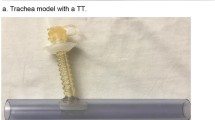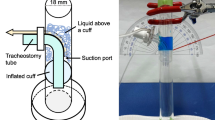Abstract
The purpose of this study was to compare the cuff pressures of three tracheostomy tubes, MERA sofit CLEAR, Blue Line Tracheostomy Tube, and Tracheosoft. Each tracheostomy tube with an internal diameter of 7.0 mm was put into a plastic column. The cuff was then inflated with air to seal the column, and the column was filled with water. The air in the cuff was withdrawn gradually and the cuff pressure at the point of water leakage was measured. Six columns of different size were used. In columns with an internal diameter of 18–21 mm, the water leakage pressure was lower in the following order: MERA sofit CLEAR < Tracheosoft ≤ Blue Line Tracheostomy Tube. A mongrel dog was tracheotomized, and each tracheostomy tube with an internal diameter of 7.5 mm was intubated. The cuff air was increased by 1 ml from 4 ml to 10 ml, and the intracuff pressure was then measured. The intracaff pressure of the Blue Line Tracheostomy Tube was the highest at the same cuff volume, and that of the Tracheosoft was next. Based on these results, the MERA sofit CLEAR was found to maintain most safely the lowest intracuff pressure to seal the trachea among the three tracheostomy tubes tested.
Similar content being viewed by others
References
H Tu N Saidi T Leiutaud S Bensaid V Menival P Duvaldestin (1999) ArticleTitleNitrous oxide increases endotracheal cuff pressure and the incidence of tracheal lesions in anaesthetized patients Anesth Analg 89 187–190
U Nordin CE Lindholm M Wolgast (1977) ArticleTitleBlood flow in the rabbit tracheal mucosa under normal conditions and under the influence of tracheal intubation Acta Anaesthesiol Scand 21 81–94
RD Seegobin GL van Hasselt (1984) ArticleTitleEndotracheal cuff pressure and tracheal mucosal blood flow: endoscopic study of effects of four large volume cuffs BMJ 288 965–968
S Joh (1986) ArticleTitleImpairment of tracheal mucosal blood flow by endotracheal tube cuffs and its recovery: a study on changes in blood flow and partial pressure of oxygen in tracheal mucosa (in Japanese with English abstract) Handai Shigaku Zasshi (J Osaka Univ Dent Soc) 31 334–350
S Joh H Matsuura Y Kotani K Sugiyama Y Hirota Y Kiyomitsu Y Kubota (1987) ArticleTitleChanges in tracheal blood flow during endotracheal intubation Acta Anaesthesiol Scand 31 300–304
K Sato M Tanaka T Nishikawa (2004) ArticleTitleChanges in intracuff pressure of endotracheal tubes permeable or resistant to nitrous oxide and incidence of postoperative sore throat (in Japanese with English abstract). Masui Jpn J Anesthesiol 53 767–771
A Dullenkopf A Schmitz M Frei AC Gerber M Weiss (2004) ArticleTitleAir leakage around endotracheal tube cuffs Eur J Anaesthesiol 21 448–453
AMS Black RD Seegobin (1981) ArticleTitlePressures on endotracheal cuffs Anaesthesia 36 498–511
P Young M Rollinson G Downward S Henderson (1997) ArticleTitleLeakage of fluid past the tracheal tube cuff in a benchtop model Br J Anaesth 78 557–562
Author information
Authors and Affiliations
About this article
Cite this article
Nishiyama, T. Comparison of the intracuff pressures of three different tracheostomy tubes. J Anesth 19, 260–262 (2005). https://doi.org/10.1007/s00540-005-0324-2
Received:
Accepted:
Issue Date:
DOI: https://doi.org/10.1007/s00540-005-0324-2




